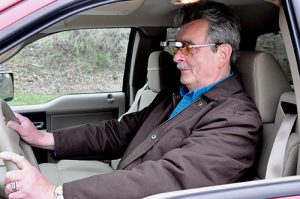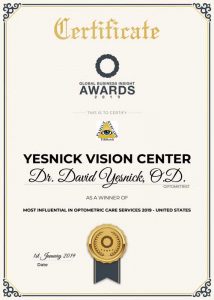What Is A Bioptic Telescope?
A bioptic telescope is a small device mounted on a spectacle lens above the normal visual axis of the user. It is usually angled slightly upwards. With bioptics, the wearer uses his normal eyeglasses for most activities. The patient employs the biopic telescope when needed by lowering the chin and focusing through the telescope to see a magnified image. This movement from the original view to the magnified view is known as ‘transition’.
This device is most suitable for someone who has mild to moderate low vision. For example, someone who has trouble with central vision but has good peripheral vision, as is common with patients that have macular degeneration, stargardt Disease and retinitis pigmentosa.
Who Can Drive With Bioptic telescopes?
 In most states, people who have a mild to moderate issues with their central vision and have a good peripheral vision can be considered for driving using bioptic telescopes by the DMV.
In most states, people who have a mild to moderate issues with their central vision and have a good peripheral vision can be considered for driving using bioptic telescopes by the DMV.
Since a person will not use bioptic telescopes the whole time he is driving, he first needs to be a good driver without the telescopes.
In order to be declared a safe bioptic driver, several tests are conducted both behind the wheel and outside the car with the bioptic telescopes on. At YESnick Low Vision in Las Vegas, our low vision optometrist, Low Vision Therapist, and driving instructor will work with the patient involved to help them get the right prescription, use the bioptics, and pass their drivers test.
How To Drive With Bioptic Telescopes
While driving, the bioptic telescope is used for around 3 percent of the time and uses the regular spectacles for more than 95 percent of the time.
You may think of it as using the rear-view mirror, where we look through it only when needed. The driver uses the bioptic telescopes only when needed, to assess traffic and objects at a distance such as stop lights and street signs.
Techniques To Master
To be a safe bioptic driver, you need to excel in the following techniques:
Scanning
Using this technique, the driver scans traffic conditions at a distance of around a hundred yards or more, using the bioptic telescopes, helping the driver see things that may be difficult to see using their regular prescription eyeglasses.
Spotting
This is another tricky technique to master. In this, the driver needs to use his eyeglasses and locate an object, then with a quick transition, use his bioptic lenses to identify the object, and then quickly returns to the original lenses. This entire process needs to be done very quickly and should be reflexive; thus, this takes time and practice to master.
Factors That Influence Visibility
The following are the factors that may impact visibility while driving:
- Object Vision - Not all objects need to be exactly identified. In most cases, it would suffice to know that an object is present and that it needs to be avoided. The bioptic driver may face the challenge of deciding which object to look at in the telescope and which one to avoid.
- Visual Clutter - Similar to the above point, there are a lot of objects on the road - some stationary, some mobile. Again, the driver needs to pick objects of importance from the field of view. If he or she can differentiate between different types of objects like trees, poles, signposts, and moving vehicles and pedestrians, it would make him a safe driver.
- Driving Speed - While all the above scanning and spotting may be feasible at average speeds, it would become difficult at higher speeds when everything needs to be done at a lightning pace. Moreover, movement through the telescope would look more pronounced, making it more difficult. Therefore, a bioptic driver is safer on roads with lower speed limits.
Why Choose YESnick Low Vision To Help You Get Back On The Road?
We are proud to be a world wide leading low vision driving practice. Our low vision optometrist and low vision therapist have extensive experience working with patients to help them regain their license using bioptic telescopes. As part of our effort for low vision drivers' training YESnick Low Vision operates a high technology driving school with virtual simulators to help patients adjust to their bioptic telescopes. The patient can drive in different weather and road conditions which help bring a level of confidence before taking the road test at the DMV.
Click here to learn more about driving with low vision.

